I am trying to learn electronics by looking at simple circuits and see how engineers get the job done.
Looking at a PCB featuring only one Texas Instruments ADS1115 ADC, I see that:
- They bridge VCC and GND with a capacitor as close as possible to the power lines arriving at the PCB. I guess it's 100µF (shown in the picture).
- They do the same on the VCC and GND as close as possible to the chip (not shown in the picture).
- They have pull-up 10K resistors on the SDA, SCL and ADDRESS lines. I guess it's because they wish those to be high when not driven (not shown in the picture).
However, I do not understand why they have two parts (black 0805) inserted in the VCC and GND lines arriving on the board (shown at the top of the picture). Are these resistors ? What would their purpose be ? The board can be powered from 1.8 to 5 V.

Maybe they are only diodes? In that case, the polarity should be marked. And there would be a voltage drop across.
I am also puzzled, because these parts are across the VCC as well as the GND. In my mind, there is never any part splitting the GND line.